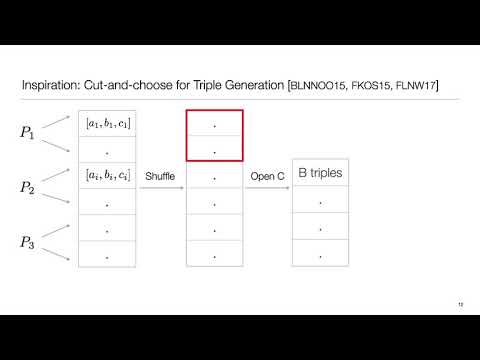Welcome to the resource topic for 2020/338
Title:
Improved Primitives for MPC over Mixed Arithmetic-Binary Circuits
Authors: Daniel Escudero, Satrajit Ghosh, Marcel Keller, Rahul Rachuri, Peter Scholl
Abstract:This work introduces novel techniques to improve the translation between arithmetic and binary data types in secure multi-party computation. We introduce a new approach to performing these conversions using what we call extended doubly-authenticated bits (edaBits), which correspond to shared integers in the arithmetic domain whose bit decomposition is shared in the binary domain. These can be used to considerably increase the efficiency of non-linear operations such as truncation, secure comparison and bit-decomposition. Our edaBits are similar to the daBits technique introduced by Rotaru et al. (Indocrypt 2019). However, we show that edaBits can be directly produced much more efficiently than daBits, with active security, while enabling the same benefits in higher-level applications. Our method for generating edaBits involves a novel cut-and-choose technique that may be of independent interest, and improves efficiency by exploiting natural, tamper-resilient properties of binary circuits that occur in our construction. We also show how edaBits can be applied to efficiently implement various non-linear protocols of interest, and we thoroughly analyze their correctness for both signed and unsigned integers. The results of this work can be applied to any corruption threshold, although they seem best suited to dishonest majority protocols such as SPDZ. We implement and benchmark our constructions, and experimentally verify that our technique yield a substantial increase in efficiency. EdaBits save in communication by a factor that lies between 2 and 60 for secure comparisons with respect to a purely arithmetic approach, and between 2 and 25 with respect to using daBits. Improvements in throughput per second are slightly lower but still as high as a factor of 47. We also apply our novel machinery to the tasks of biometric matching and convolutional neural networks, obtaining a noticeable improvement as well.
ePrint: https://eprint.iacr.org/2020/338
Talk: https://www.youtube.com/watch?v=HNEGbD3kK_Y
See all topics related to this paper.
Feel free to post resources that are related to this paper below.
Example resources include: implementations, explanation materials, talks, slides, links to previous discussions on other websites.
For more information, see the rules for Resource Topics .
